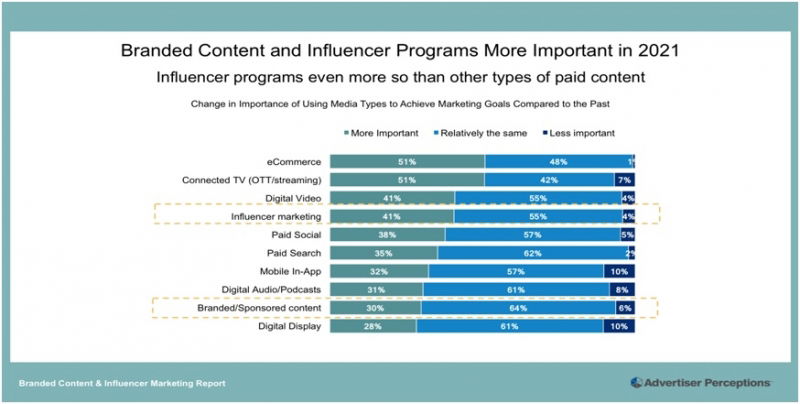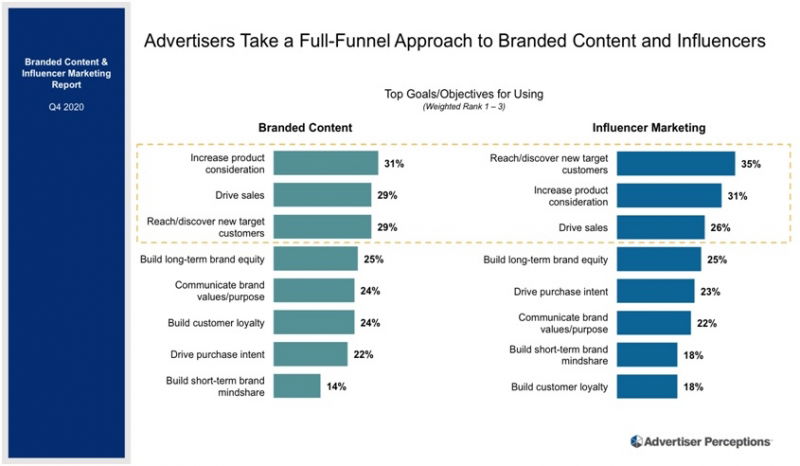
Advertisers increasing spend on branded content and influencer marketing post-COVID
share on
More than half of advertisers using paid branded content and influencers say doing so is more critical than it was a year ago, according to a branded content and influencer marketing report by market research firm Advertiser Perceptions. Throughout the second half of 2020, the report found that 32% of respondents increased spending on branded content and 25% spent more to back influencers. They are now putting 20% of their digital budgets into these complementary practices, which is more than they put into any other digital channel - paid search (14%), display (13%), paid social (12%), and digital video (12%). Advertiser Perceptions interviewed 205 advertisers in the US for its report in November, of which 46% are brand marketers and 54% are from agencies.

Among those already running branded content or influencer programmes, Advertiser Perceptions found that only eCommerce and connected TV/OTT have increased in importance to advertisers more than influencer marketing. Four in 10 say influencer marketing has become more important, ahead of paid social, paid search, mobile in-app, digital audio, and branded content which 30% of advertisers say has become more important.
This increase in branded content and influencer marketing comes as the two prove to be flexible strategies, the report said. Advertisers are using branded content and influencers for more reasons, the top three being to increase product consideration, drive sales, and reach new target consumers. While advertisers want deeper engagement with their target audiences from both strategies, they also look to influencers for audience receptivity and newsworthiness, whereas branded content enables more complex storytelling.

Two-thirds of advertisers also said branded and influencer content is easier to execute than it was two years ago. “Influencers and their packages are easier to identify, and pricing is more transparent than it used to be. There is more expertise on what works, and how to leverage an influencer’s assets," Sarah Bolton, EVP, business intelligence at Advertiser Perceptions, said.
It was also found that although Facebook, Instagram and YouTube are still the top venues for such branded and influencer content, short-form video is the first choice for advertisers. It is notable that TikTok has also overtaken LinkedIn as an influencer target, as 35% of advertisers shortlist TikTok, as compared to 29% who shortlist LinkedIn.
(Read also: TikTok appoints agency partner for branded content, looks to grow team)
“Many advertisers returned from lockdowns without their supply systems fully in place, so they had to prioritise upper-funnel activity again. Because it seemed insensitive to hard-sell products, they leaned on influencer marketing to drive awareness and humanise their brands," Bolton said, adding that branded content and influencer programmes allow advertisers to move their efforts up and down the funnel unexpectedly, which proves useful for any campaign goal.
Despite the interest in branded content and influencer programmes, the report found that this strategy presents a challenge to media sales organisations, because most advertisers lack a central team and increasingly more parts of the marketing organisation are getting involved. For media to play successfully in the emerging space, sellers need to coordinate with content, digital, and PR teams, which are aligned differently for each brand, Bolten said, adding: "They need to coordinate between creative, digital, media, PR and in-house agencies".
The integration of click-to-buy options in its brand and influencer content also appeals to advertisers, with more than one-third prioritising partners that can put click-to-buy links in their branded and influencer content. Altogether, 80% want shoppable content for influencers, while 74% want it in branded content. Bolton said: “Media companies need to bring influencer marketing into their branded content sales. An important part of that is shoppable ads. Otherwise, they are missing out on the areas advertisers are most excited about.”
Aside from the increased emphasis on branded content and influencers, advertisers are now more willing to approach “risky content". The report found that two-thirds of advertisers are willing to sponsor pandemic-related content, while 58% said they will back racial equality topics. While respondents are split by almost half on gender parity and LGBTQ issues, most still avoid gun violence and criminal justice reform, the report said.
Photo courtesy: 123RF
Related Articles:
Influencer marketing: Whose job is it, anyway? And can we get measurement right?
Study: Influencer marketing to benefit as brands balance experiential with digital
share on
Free newsletter
Get the daily lowdown on Asia's top marketing stories.
We break down the big and messy topics of the day so you're updated on the most important developments in Asia's marketing development – for free.
subscribe now open in new window
